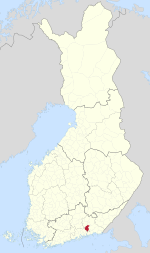Elimäki
Elimä | |
|---|---|
Former municipality | |
| Elimäen kunta Elimä kommun | |
 Elimäki wooden church | |
 Location of Elimäki in Finland | |
| Coordinates: 60°43′N 026°27′E / 60.717°N 26.450°E | |
| Country | Finland |
| Region | Kymenlaakso |
| Sub-region | Kouvola sub-region |
| Consolidated | 2009 |
| Area | |
| • Total | 391.74 km2 (151.25 sq mi) |
| • Land | 387.47 km2 (149.60 sq mi) |
| • Water | 4.27 km2 (1.65 sq mi) |
| Population (2008-12-31)[2] | |
| • Total | 8,199 |
| • Density | 21/km2 (54/sq mi) |
| Time zone | UTC+2 (EET) |
| • Summer (DST) | UTC+3 (EEST) |
Elimäki (Swedish: Elimä) is a former municipality of Finland.
It was located in the province of Southern Finland and was part of the region of Kymenlaakso. The municipality had a population of 8,199[2] and covered an area of 391.74 km² of which 4.27 km² was water.[1] The population density was 21.2 inhabitants per km².
The municipality was unilingually Finnish.
Of note is the village of Koria, the largest village in Elimäki, possessing a population of 5,100. Koria is located 6,7 km west of Kouvola.
As of 2009, the six municipalities – Kouvola, Kuusankoski, Elimäki, Anjalankoski, Valkeala and Jaala – were consolidated, accounting for the new municipality of Kouvola with a population of over 80,000, being the 10th largest city in Finland.
Arboretum Mustila is located near Elimäki.
People born in Elimäki
[edit]- Jenny af Forselles (1869 – 1938)
- Väinö Kajander (1893 – 1978)
- Ilmari Salminen (1902 – 1986)
- Erkki Pakkanen (1930 – 1973)
- Kaarina Dromberg (1942 – )
- Jarmo Wasama (1943 – 1966)
- Osmo Puhakka (1948 – )
- Pentti Sinersaari (1956 – )
- Tuija Toivonen (1958 – )
- Anita Lehtola-Tollin (1967 – )
References
[edit]- ^ a b "Area by municipality as of 1 January 2008" (PDF) (in Finnish and Swedish). Land Survey of Finland. Retrieved 27 March 2010.[permanent dead link]
- ^ a b "Population by municipality as of 31 December 2008". Population Information System (in Finnish and Swedish). Population Register Center of Finland. Archived from the original on 2010-12-02. Retrieved 27 March 2010.
External links
[edit]![]() Media related to Elimäki at Wikimedia Commons
Media related to Elimäki at Wikimedia Commons


Well, that’s interesting to know that Psilotum nudum are known as whisk ferns. Psilotum nudum is the commoner species of the two. While the P. flaccidum is a rare species and is found in the tropical islands. Both the species are usually epiphytic in habit and grow upon tree ferns. These species may also be terrestrial and grow in humus or in the crevices of the rocks.
View the detailed Guide of Psilotum nudum: Detailed Study Of Psilotum Nudum (Whisk Fern), Classification, Anatomy, Reproduction